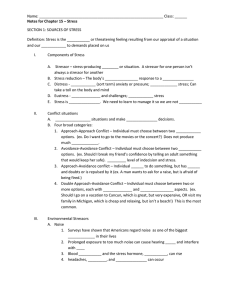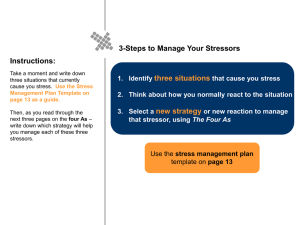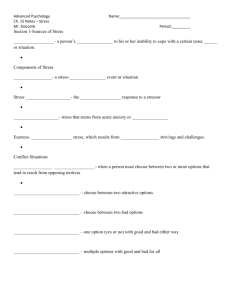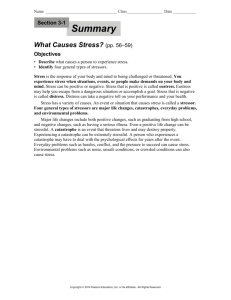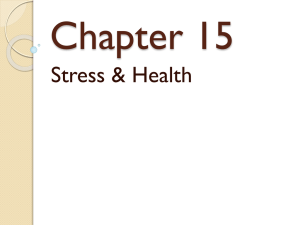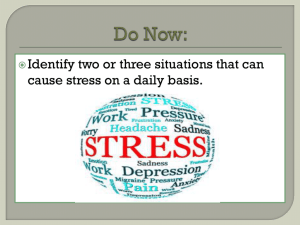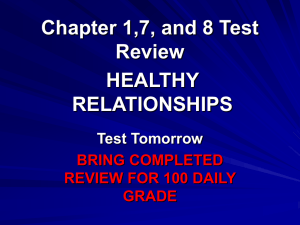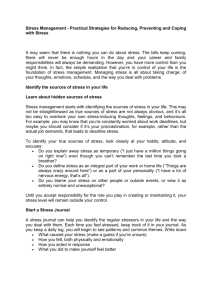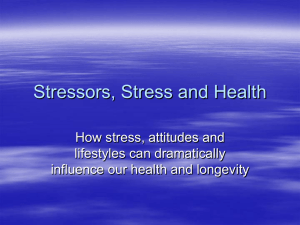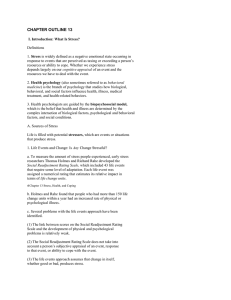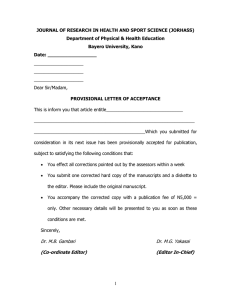PSY101_Chap10_03
advertisement
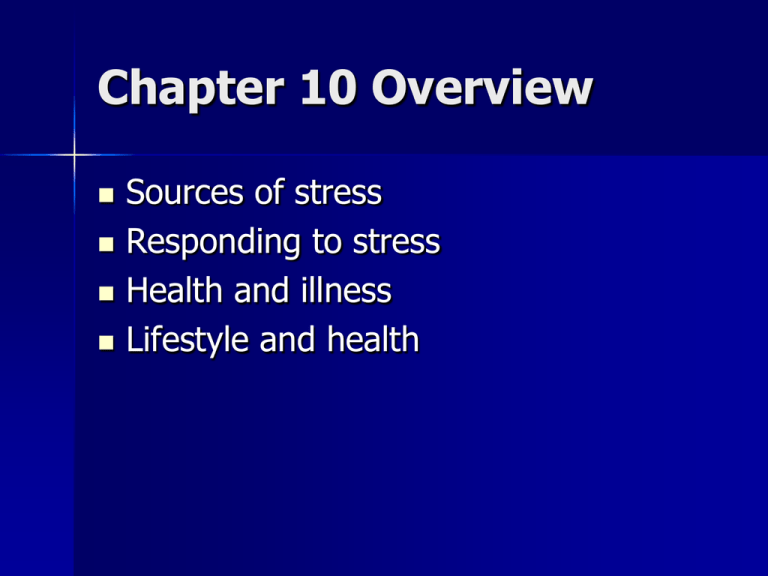
Chapter 10 Overview Sources of stress Responding to stress Health and illness Lifestyle and health Sources of Stress Stress is the physiological and psychological response to a condition that threatens or challenges a person and requires some sort of adaptation Stress is associated with the fight or flight response – Response in which the nervous system and endocrine glands prepare the body to fight or flee Stressors – Stimuli or events that can produce physical or emotional stress What was the Social Readjustment Rating Scale designed to reveal? Developed by Holmes and Rahe to measure stress Life events that produce the greatest life changes are considered the most stressful – Whether the changes are positive or negative Scale assigns point values to 43 life events – – – – Death of a spouse: 100 Getting fired at work: 47 Beginning or ending school: 26 Vacation: 13 What was the Social Readjustment Rating Scale designed to reveal? SRRS scores are correlated with a variety of health indicators – Scores over 300 80% chance of major health problems within two years – Scores of 150-300 50% chance of major health problems within two years Main criticism of SRRS – It assigns point values to life events without taking into account how an individual perceives or copes with each stressor What roles do hassles and uplifts play in the stress of life, according to Lazarus? According to Richard Lazarus, hassles cause more stress than major life events – Hassles are little stressors encountered in daily life Research has found that hassles are significantly related to health problems – But uplifts may neutralize the effects of hassles How do choice-related conflicts and lack of control contribute to stress? Making choices can be stressful Three choice-related conflicts: – Approach-approach conflict Having to choose between equally desirable alternatives – Avoidance-avoidance conflict Having to choose between undesirable alternatives – Approach-avoidance conflict Conflict arising when the same choice has desirable and undesirable features How do choice-related conflicts and lack of control contribute to stress? People feel less stress when a stressor is predictable than when it is unpredictable People also feel less stress when they have a sense of control over a situation – Langer & Rodin (1976): Nursing home residents are healthier and happier when they feel they have control over some aspects of their lives – Glass & Singer (1972): Loud noises are less stressful when participants can terminate the noise, even if they don’t choose to do so For people to function effectively and find satisfaction on the job, what nine variables should fall within their comfort zone? According to Albrecht (1979), effective functioning and job satisfaction depend on nine variables being within one’s comfort zone – – – – – – – – – Workload Clarity of job description and evaluation criteria Physical variables Job status Accountability Task variety Human contact Physical challenge Mental challenge How do people typically react to catastrophic events? Most people cope well with catastrophic events But some develop posttraumatic stress disorder (PTSD) – A prolonged, severe stress reaction, often characterized by flashbacks or nightmares – PTSD is associated with increased risk of suicide, depression, and alcohol abuse How do racism, socioeconomic status, and unemployment affect health? Some researchers believe that African Americans have higher blood pressure than other groups because of stress due to historical racism People with low socioeconomic status have more stress-related health problems than those with higher status – Although perceived status may be more predictive of health problems than actual status Unemployment is also associated with increased incidence of health problems Responding to Stress Psychologists have different views of the ways in which people respond to stressful experiences. Each approach can help us gain insight into our own experiences to deal more effectively with stress. What is the general adaptation syndrome? Proposed by Hans Selye (1907-1982) The general adaptation syndrome (GAS) is a predictable sequence of reactions that organisms show in response to stressors It consists of three stages – Alarm stage – Resistance stage – Exhaustion stage What is the general adaptation syndrome? Alarm stage – Adrenal cortex releases glucocorticoids – Increased heart rate, blood pressure, blood sugar energize body for fight or flight Resistance stage – Intense physiological efforts made to resist or adapt to stressor Exhaustion stage – Occurs if organism fails to resist or adapt to stressor – Stores of energy are depleted, resulting in exhaustion and eventually death What are the roles of primary and secondary appraisals when a person is confronted with a potentially stressful event? Primary appraisal – Cognitive evaluation of a potentially stressful situation to determine if its effect is positive, negative, or irrelevant Secondary appraisal – Cognitive evaluation of available resources and options for dealing with a stressful situation – Level of perceived stress is largely based on whether one’s resources are perceived as adequate for dealing with the stressor What is the difference between problem-focused and emotion focused coping? Problem-focused coping – A direct response aimed at reducing, modifying, or eliminating a source of stress Emotion-focused coping – A response involving reappraisal of a stressor to reduce its emotional impact A combination of these strategies is probably the best stress-management technique – e.g., a heart-disease patient making lifestyle changes such as diet and exercise (problemfocused) and maintaining an optimistic outlook to deal with anxiety (emotion-focused) Health and Illness Wellness is a term associated with a new approach to thinking about health, encompassing a growing emphasis on lifestyle, preventive care, and the need to maintain wellness rather than thinking of health matters only when the body is sick. How do the biomedical and biopsychosocial models differ in their approaches to health and illness? Biomedical model – A perspective that explains illness solely in terms of biological factors – The predominant view in medicine for many decades Biopsychosocial model – A perspective that views health and illness as determined by a combination of biological, psychological, and social factors – Growing acceptance of this model has given rise to the field of health psychology What are the Type A, Type B, and Type D behavior patterns? Type A behavior pattern – Time urgency, impatience, competitiveness, hostility, and anger – Associated with increased risk for coronary heart disease Type B behavior pattern – Relaxed, easygoing approach to life, without time urgency, competitiveness, and hostility – Associated with lower risk of coronary heart disease Type D behavior pattern – Emotional distress combined with tendency to suppress negative emotions – Associated with increased risk of coronary heart disease How do psychological factors influence cancer patients’ quality of life? Research has identified several psychological factors that can improve quality of life and reduce distress in cancer patients – – – – Maintaining an optimistic outlook Accepting the reality of the situation Keeping a sense of humor Social support Coping strategies that increase distress include – Denial – Social withdrawal What personal and social factors are associated with health and resistance to stress? Optimism – Optimists are more stress-resistant than pessimists, and had lower death rates in a longterm study in Finland Hardiness – Combination of commitment, control, and challenge – Hardy individuals tend to remain healthy despite high levels of stress What personal and social factors are associated with health and resistance to stress? Religious faith – Religious involvement is associated with lower rates of cancer, heart disease, and stroke Social Support – Tangible and/or emotional support provided by family members, friends, and others – People with high levels of social support Are less likely to catch colds Have lower levels of depression when suffering from chronic illnesses Recover faster from illness Have higher probability of surviving a heart attack Lifestyle and Health Researchers have found that people are more likely to adopt healthy behaviors if they believe behavioral change will make them look better or appear more youthful than if they simply receive information about the health benefits of the suggested change. Still, there are some health-threatening behaviors that carry such grave risks that everyone ought to take them seriously. Why is smoking the most dangerous health -threatening behavior? Smoking is the #1 cause of preventable diseases and deaths in the USA – Directly related to over 400,000 deaths each year Smoking is related to – Heart disease, lung cancer, chronic bronchitis – Low birth weight and retarded fetal development in babies born of smoking mothers Passive smoking is related to – Increased risk of heart attack What are some health risks of alcohol abuse? Excessive alcohol consumption can damage virtually every organ in the body, including the liver, stomach, heart, and brain – CT scans show brain shrinkage in alcoholics Compared to nonalcoholics, alcoholics – Are three times more likely to die in car accidents – Are twice as likely to die of cancer Recent studies suggest that brain-imaging techniques may someday be able to identify individuals who have a genetic predisposition for alcoholism
